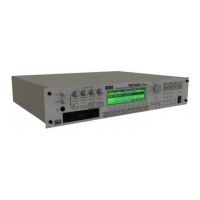138
When the dialog box appears, “Volume Label” will
show the volume label that had been specified before
formatting. If a disk that has no volume label or a non-
DOS disk is inserted, this will indicate “NEW VOL-
UME.”
5 Specify the initialization format. Normally you should
use Quick Format to initialize the disk, and use Full For-
mat if an error message of “Disk not Formatted” appears.
Quick Format: Selects this if the media has already been
physically formatted. Since only the system area of the
media need be formatted, this will require less time.
Full Format: Selects this when formatting media that has
not been physically formatted. You should also select this
type of formatting if writing errors occur frequently with
this media.
It is not necessary to perform a Full Format on SCSI
media that has been physically formatted at 512 bytes/
block. Perform the Quick Format for such media.
The TRITON-Rack cannot format media with a format of
other than 512 bytes/block (such as 640 MB, 1.3 GB MO
disks etc.).
6 To format the media, press the [F8] (“OK”) key. To cancel
without formatting, press the [F7] (“Cancel”) key.
After a floppy disk has been formatted by the TRITON-
Rack, a 2HD floppy will hold 1.44 MB (18 sectors/track),
and a 2DD floppy will hold 720 KB (9 sectors/track). A
maximum of 4 GB can be formatted on an external SCSI
device connected via the EXB-SCSI (sold separately).
1.1–4a: Drive (Drive select)
This displays information on the media that is selected by
“Drive Select.”
☞ 1.1–1c: Drive select
Vol. Label (Volume Label):
The volume label of the media.
SCSI ID:
The specified SCSI ID. If the TRITON-Rack’s internal floppy
disk drive is selected, “–” will be displayed.
Dev. Type (Device Type):
The type of media.
Product ID:
The vendor ID, product, and product version, etc.
Format (Format Type):
The type of format. If not formatted, this will indicate
“Unformatted.”
Total Size:
The capacity of the media (in bytes).
Free Size:
The free capacity of the media (in bytes).
Write Protect:
The write protect status of the media. This will indicate
“On” if protected, or “Off” if not protected.
Removable (Supports Removable):
This will indicate “Yes” if the media of the selected device
can be removed (e.g., floppy disk, MO disc, removable hard
disk). If the media is fixed, this will be “No.”
1.1–4b: UTILITY
Scan SCSI device
This command allows you to re-mount a connected SCSI
device if the EXB-SCSI option is installed.
1 From the Utility menu, select “Scan SCSI device.” The
currently-connected SCSI devices will be re-scanned (if
the EXB-SCSI option is installed). Once scanning is com-
pleted, any valid SCSI device can be selected in “Drive
Select.”
Never connect or disconnect a SCSI cable while the
power of the TRITON-Rack or of a SCSI device is
turned on. Doing so can cause irreparable malfunc-
tions.
1.1–4: Media Information
1.1–4a
1.1–4b

